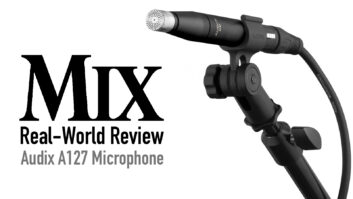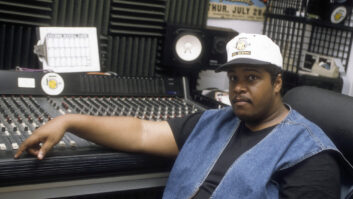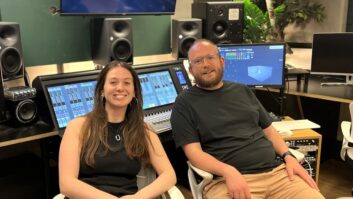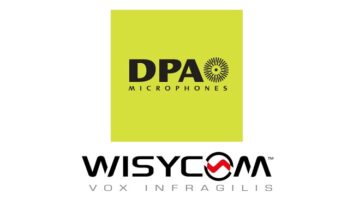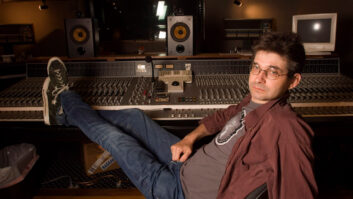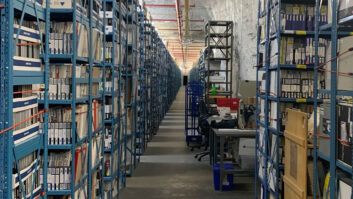Drummer and producer Francesco Lucidi is a household name in Europe and is rapidly winning hearts and minds in the USA. Best known for touring with Italian rap-pop megastar Rkomi and singer-rapper Irama, he also drummed in 2020’s Vivaldi Metal Project, an all-star symphonic metal extravaganza conceived by Bruce Dickinson keyboardist Mistheria. When he’s not on the road, he operates his own recording facility and artistic hub, Studio 86, located in the famously lush region of Umbria. Francesco has also worked with AUDIX and created a soundtrack that was recorded at MOYSA, an incredible studio in Milan. For both live and studio projects, he keeps an extensive lineup of AUDIX microphones at hand, including the dynamic flagship PDX720; A231 large-diaphragm and SCX1 small-diaphragm condensers; D6, D4, and D2 for kick and toms; the workhorse i5 for snares and other instruments, and MicroD. He spoke with us about his applications and techniques for each, and the clarity that keeps him coming back to AUDIX for all his miking needs.
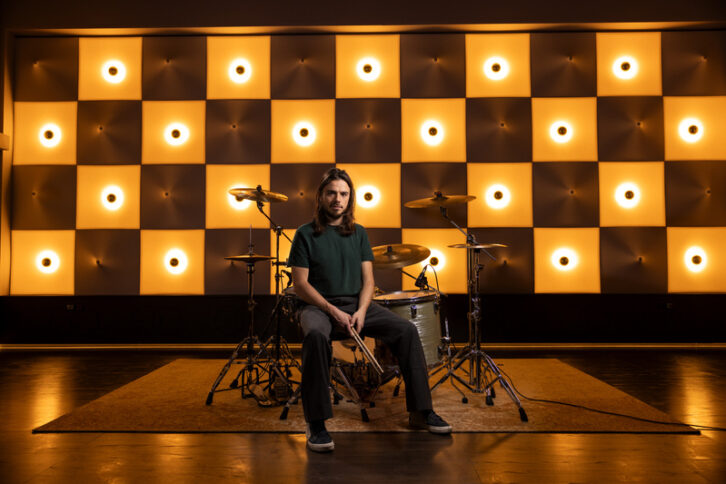
Tell us a little about your musical background.
I’m a rock drummer. I grew up listening to lots of heavy stuff. Nowadays, loads of pop and rap artists in Italy want rock drums, I can do more or less what I want, like using a double kick drum in any style of music! [Laughs.] I started drumming as a child at age 11 and had played guitar before that. I’m often still on guitar when I play TV shows with Rkomi. My brother is a keyboard player. I won a scholarship to music school, which is what got me to London. As a teenager I had wanted to attend Berklee College of Music in the U.S., but it was sort of a dream because I didn’t have the money.
Who are your biggest musical influences?
My first loves as bands were Queen and [progressive metal group] Dream Theater. So, my hero growing up was Dream Theater’s drummer Mike Portnoy. I’ve liked heavy hitters ever since, and my own playing certainly leans in that direction. So, my drum mics need to be able to take it without breaking up or losing any information.
Francesco Lucidi at MOYSA Studios in Milan, crafting a mesmerizing soundtrack, expertly captured using a variety of AUDIX microphones, including the DP7 drum pack, ADX51 on hi-hat and ride, D2 on rack tom and D4 on floor tom, and the A231 as overheads.
What brought you back to your native Italy?
I had a studio in London, where I lived for about 15 years. Then, Brexit and Covid happened, so work there went downhill quick, but the upside was that I did learn a lot about remote recording and collaboration. I left London, lived in Moscow for one year, then moved back to Italy where my wife and I built a studio in Umbria. It’s a big space, about 150 square meters. We’re about an hour and a half’s drive from Rome.
I want to make something happen in Italy because here, you’ll hear a lot of people complain that there isn’t more happening in the music scene, but very few seem to want to do anything about it. I wanted to do something. The next step will be to come to the U.S. to play with artists there. I’ve been only a couple of times, including this past NAMM Show.
How and when did you first become aware of AUDIX microphones?
I knew the mics because I used them in the U.K. In London, you’ll find the D6 on the kick drum in almost every venue. I used to see them in recording studios as well — mostly the D6 and the i5 on snare. For the audio engineering part of my studies there, I recorded a lot of drums with those mics, and often re-recorded my own if I didn’t like the beats! When I returned to Italy, I wanted to use them here in my studio.
Which AUDIX mics are you currently using on your drums?
The D6 and i5, of course, and also the new PDX720, which I have tried on snare. I’ve also used it alongside the A231 to mic a guitar cabinet, and the combination sounds amazing. I have to say the PDX720 looks amazing — maybe that’s because I’m Italian and I love design.

Other than the appearance, what drew you to the PDX720 in particular?
It has switches for a low cut and a midrange presence boost. I typically use the low cut at 155Hz and the boost at 3dB. On snare and guitar cabinet, those settings give me a great sound straight away, with little to no EQ, compressor, or other post-processing.
That’s an interesting application, because a lot of podcasters are discovering the PDX as a studio mic.
You know, so many people talk about it as a podcasting mic for spoken word, and it’s certainly good at that, but it also can sound phenomenal on singing. Especially on the heavy rock and metal that I like, because a lot of the lead vocalists are screamers, and they hold the mic. That the PDX is dynamic instead of a condenser makes it ideal for that situation. It’s not too sensitive, and it stands up to the sound levels they can put out. It absorbs physical shock well, too, and often I haven’t even needed a pop filter. I like to experiment — to live dangerously a little! [Laughs.]
Also relevant, I just used the PDX on a session with a band from Poland. The Polish language has a lot of sharp consonant blends, so think sibilance and plosives. A condenser would have had a hard time with that, but the PDX smoothed them out just enough without losing any of the definition.
What other mics, if any, are you using on your drums and other instruments, either live or in the studio?
I’ve fallen in love with the MicroD on toms because of its compact size and ease of mounting right on the shell. With really heavy hitters, I might use a D2 or a D4 instead, but the MicroD just has this clarity to it — the toms glisten in a way you usually don’t think of toms doing. I will also use a D6 on floor tom. The last tour with Rkomi and Irama, we had 16- and 18-inch floor toms, with a D6 on each. The same qualities that make it great on kick are ideal for capturing a warm, round sound from the floor toms.
The D6 has a fullness for low-end sources I haven’t heard from anything else. Move it closer to the beater, and you’ll get that nice, clicky kick attack of great metal recordings. Move the mic out, and it gets fatter.
You mentioned the A231, which AUDIX sells as a studio/vocal condenser, on guitar cab? Can you talk about that and other favorite applications for it?
I love them as studio drum overheads and as room mics. I have a pair of A231 and of SCX1, depending on whether I want to use a large- or a small-diaphragm condenser. For recording, I love the SCX1 on hi-hat and ride cymbals.

Describe some hallmarks of the way you record and produce. They could be tips and tricks or anything along those lines.
When recording a drum kit, I will place a single i5 on the floor so that it picks up the bottom of the snare and some energy from the kick, roughly equally. I will then record that on its own track. Mixing a little of it in can add both sparkle and body to the overall sound.
Also, in my studio, I will place one A231 in the bathroom with the door open. The far room sound this captures can be the glue that holds the song together, and I can just mix as much in as I need from its own track.
Probably the biggest thing is that I like to record the sound of the actual kit! I know that sounds obvious, but a lot of younger producers use an acoustic kit mainly as a trigger for sampled or virtual drums. This is why a lot of Italian pop sounds the same — they’re getting any identity for those sounds using effects after the fact. I like to get my identity in the organic realm by experimenting with mic positions. AUDIX mics let me do that without driving myself crazy turning knobs.
What is it about AUDIX in general that lets you do that?
If I had to boil that down to one word, clarity. If I’ve matched the right mic to the application, it’s like I’m hearing the instrument itself when I’m listening in the control room. With AUDIX, I don’t feel like I’m hearing the mic, or even my monitor speakers. I feel like I’m hearing the essence of the source the mic is recording.
What new projects coming up are you excited about?
One of my long-term ambitions is to create a sort of arts center here. We have already recorded and streamed concerts from the live room, sort of like NPR’s Tiny Desk series. I want to do something similar with master classes. I’d like to facilitate up-and-coming musicians networking and helping each other. Artists rehearsing for a tour or writing an album could stay here. I want to create a place where people gather to make music.
Rkomi and I are writing his new album and he’s coming here to my studio in about a month. I am also planning some in-person master classes here for recording, which I think will be useful for a lot of musicians with home studios. I’m not a multi-millionaire with a famous vintage console — I’ve made a nice space here, but I’m far closer to the kid with a few pieces of gear in a spare bedroom than I am to a rock star with all the tools in the world.
Speaking of which, would you recommend AUDIX to that spare-bedroom kid who’s putting his first recording rig together?
I’d say a great starting place would be those ready-made drum miking kits AUDIX sells. A nice, affordable one is called the DP7, and it has a D6, a couple of D2, a D4, an i5, and a pair of ADX51 for overheads, plus all the clamps and mounting hardware you need. It all comes in a little briefcase so it’s very easy to use live, and I think it’s over a thousand bucks in U.S. money. They have sets that go up and down from there.
How about some career advice for that same aspiring producer?
Experiment! I believe that you should try a new recording technique as often as you can, even if it sounds crazy. No matter how good you get or how much money you make, we are all students up until our last day on earth. Spend your time learning and life becomes beautiful.
